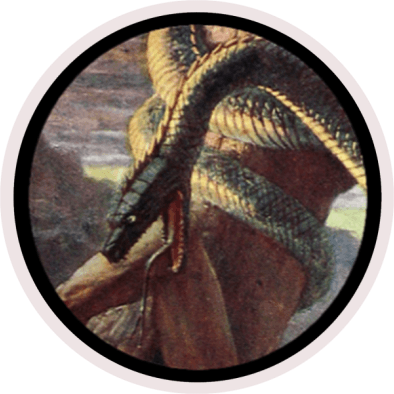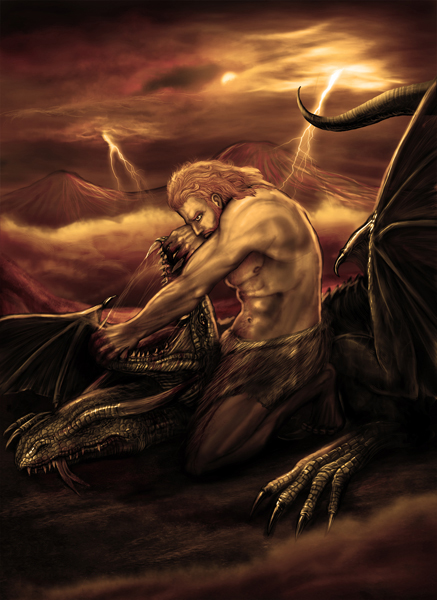Mighty Serpent

In Hindu religion the adversary of the Thunder God Indra was called Vṛtra. Vritra was also known in the Vedas as Ahi (in Sanskrit अहि ahi means snake). Vṛtra stole the waters of the Earth and caused a global draught. Only the death of that enormous serpent caused by a thunderbolt resulted in the release of stolen water.
In Greek religion Typhon was a monstrous serpentine giant and one of the deadliest creatures. According to Hesiod, Typhon was the son of Gaia and Tartarus. Typhon and his mate Echidna were the progenitors of many famous monsters. Typhon attempted to overthrow Zeus for the supremacy of the cosmos. The two fought a cataclysmic battle, which Zeus finally won with the aid of his thunderbolts. Defeated Typhon was cast into Tartarus or buried underneath Mount Etna, or the island of Ischia.
In Norse religion one sign for the coming of Ragnarok is the violent unrest of the sea as Jörmungandr releases its tail from its mouth and thrashes its way onto land. Fenrir will set ablaze one half of the world with fire while Jörmungandr sprays poison to fill the skies and seas of the other half. Here is where the last meeting between the serpent and Thor is predicted to occur. Thor will become occupied with battling the serpent and will be unable to help others as they will fight their own battles. He will eventually kill Jörmungandr but will fall dead after walking nine paces, having been poisoned by the serpent's deadly venom.
Some of the common motifs concerning Slavic dragons include their identification as masters of weather or water source, that they start life as snakes and that both the male and female can be romantically involved with humans.
Zmei Gorynich or zmey (Russian: змей) is a dragon or serpent, or sometimes a human-like character with dragon-like traits. Zmei Gorynych and Tugarin Zmeyevich, two well-known zmei, appear as adversaries of the bogatyri (heroes) Dobrynya Nikitich and Alyosha Popovich.
A figure connected to serpents, the underworld and watery bogs in the West Slavic pantheon could be Chernobog ("Black God") but also East Slavic Veles and Polish Nyja (Nyia). The three-headed aspect of Veles could resemble the three-headed serpent and that would make him the biggest enemy of Belobog, Perun, Piorun ("Thunder"). The same idea is kept by the common Ancient North Eurasian (ANE) derived Sioux (Lakota) beliefs. The mighty serpent Unk Cekula is slain by the Wakinyan ("Thunder"). Thunderbirds (probably eagles like Garuda) are also a strong ANE connection in both Indo-European and Native American religions.
Azhdaha, Azhdahak, Ezhdeha (Persian: اژدها) or Azhdar (اژدر) is a mythical creature in Iranian mythology, roughly equal to Dragon. They are gigantic snake-like creatures living in the air, in the sea, or on the earth. Sad dar-e nathr and sad dar-e Bondahesh, Shahnameh and Garshaspnameh are among main principal texts that contain information about the creature. In Persian literature, Azhdahas are depicted as a giant snake or lizard with wings. Aži Dahāka is the most significant and long-lasting of the ažis of the Avesta, the earliest religious texts of Zoroastrianism. He is described as a monster with three mouths, six eyes, and three heads, cunning, strong, and demonic. In other respects Aži Dahāka has human qualities, and is never a mere animal.

The Avesta identifies the person who finally disposed of Aži Dahāka as Θraētaona son of Aθβiya, in Middle Persian called Frēdōn. The Avesta has little to say about the nature of Θraētaona's defeat of Aži Dahāka, other than that it enabled him to liberate Arənavāci and Savaŋhavāci, the two most beautiful women in the world. Later sources, especially the Dēnkard, provide more detail. Feyredon is said to have been endowed with the divine radiance of kings (Khvarenah, New Persian farr) for life, and was able to defeat Dahāg, striking him with a mace. However, when he did so, vermin (snakes, insects and the like) emerged from the wounds, and the god Ormazd told him not to kill Dahāg, lest the world become infested with these creatures. Instead, Frēdōn chained Dahāg up and imprisoned him on the mythical Mt. Damāvand
Armenian Vahagn fought and conquered dragons hence his title Vishabakagh "the dragon reaper". Dragons in Armenian lore are identified as Vishaps.
In Hittite and Luwian mythology Illuyanka was a serpentine dragon slain by Tarḫunz (Parkuns), the Hittite incarnation of the Hurrian god of sky and storm. After the two gods fight and Teshub (Tarḫunz) loses, Illuyanka takes Teshub's eyes and heart ("courage")[1]. To avenge himself upon the dragon, the Sky God Teshub marries the goddess Hebat, daughter of a mortal, named Arm. They have a son, Sarruma, who grows up and marries the daughter of the dragon Illuyanka. The Sky God Teshub tells his son to ask for the return of Teshub's eyes and heart as a wedding gift, and he does so. His eyes and heart restored, Teshub goes to face the dragon Illuyanka once more. At the point of vanquishing the dragon, Sarruma finds out about the battle and realizes that he had been used for this purpose. He demands that his father take his life along with Illuyanka's and so Teshub kills them both with thundery rain and lightning. This version is illustrated on a relief which was discovered at Malatya (dating to 1050 BC - 850 BC) and is on display in the Museum of Anatolian Civilizations in Ankara, Turkey.
In other version of this myth after the dragon Illuyanka wins an encounter with the Storm God, the latter asks Inara (his daughter) to give a feast (most probably the Purulli festival). Inara decides to use the feast to lure and defeat Illuyanka, who was her father's archenemy and enlists the aid of a mortal named Hupasiyas of Zigaratta by becoming his lover. The dragon and his family gorge themselves on the fare at the feast, becoming quite drunk, which allows Hupasiyas to tie a rope around them. Inara's father then kills Illuyanka, thereby preserving creation[2].
Făt-Frumos is usually the youngest son of a king. In the Romanian folk stories it is common that all the sons of a king try to defeat the Zmeu or the Balaur, the older sons failing before the younger one succeeds.
Hindu: त्रिशिरस् (Triśiras) वृत्र (Vṛtra)
Greek: Τυφῶν (Typhon) Τυφωεύς (Typhoeus) Τυφάων (Typhaon) Τυφώς (Typhos)
Norse: Jörmungandr
Persian: Aži Dahāka (Dahāg)
Armenian: Vishap
Hittite: Illuyanka
Russian: Zmey Gorynych Tugarin Zmeyevich
Polish: Żmij
Romanian: Zmeu Balaur
Albanian: Kulshedra
Aztec: Cipactli (Sipaktli)
Sioux (Lakota): Unk Cekula Unktehi (slain by Wakinyan meaning "Thunder")
*Chinese: Xiangliu
*Japanese: 大蛇 (woröti, orochi, daija) ("Large Serpent")
*Basque: Herensuge Sugaar
*Canaanite: Yam ("The Sea", "The Serpent")
*Egyptian: Apep ("The World-Encircler Serpent")
